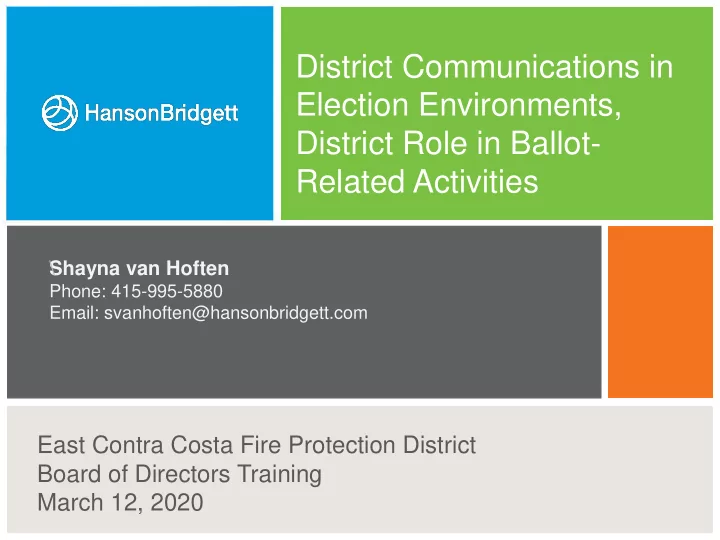

District Communications in Election Environments, District Role in Ballot- Related Activities \ Shayna van Hoften Phone: 415-995-5880 Email: svanhoften@hansonbridgett.com East Contra Costa Fire Protection District Board of Directors Training March 12, 2020
Context • “We Are Listening” outreach effort – Not associated with any “pending measure” • ECV Measure(s) – Currently in petition phase in Brentwood – May qualify for the ballot(s) (e.g., Nov. 2020) • Potential revenue enhancement measure – No decisions to be made until later in 2020 – May be traditional ballot measure (e.g., parcel tax) – May be Prop. 218 ballot proceeding (e.g., fire suppression benefit assessment) – Maybe neither
3 The Basic Rule: • No public resources for political campaigns • Campaign only with your own time and dime
Why? • Government speech can drown out other voices, distort electoral process • Taxpayer money is to be spent on agency services • It’s the law
5 What are “Public Resources”? • Money – Including paid time • Office/other supplies • Communications (phone, mail, email, website) • Facilities
6 What is a “campaign” expenditure? • Funds, time or other resources spent promoting or opposing a measure • Communications or other expenditures paid for with funds on special line item in a budget
7 What types of communications are prohibited? • “ Express advocacy,” “unambiguous urging” – Anything saying “Vote For…” or “Support…” • “Inflammatory” or “argumentative” statements • Uncommon communications – Depends on: Style, Timing, Tenor – Radio/newspaper ads, billboards, bumper stickers, lawn signs, buttons, etc.
8 What is NOT a “campaign” activity? • Gathering public input / opinions on what a measure might include • Analyzing options for what type of measure to pursue • Deciding whether to move forward • Public meeting discussions on one or more potential measures • Drafting a proposed ballot measure/Prop. 218 materials • Adopting resolutions to place a measure on the ballot or launch a ballot process and/or support (or oppose) a measure
9 What is NOT a “campaign” activity? • Presentation of neutral, balanced, educational information – Depends on: Timing, Tenor, Tone − Form of communication matters; best if consistent with/contained in other agency communications − Discuss process and/or potential consequences – Fair presentation of the facts and agency’s official view of merits • Bearing election/balloting costs • Authoring agency’s ballot statement
10 Potential Pitfalls • Wearing agency uniform while campaigning • Soliciting political contributions from agency employees • E-mail/business cards • Brown Act “serial conversation” dangers − Board/Council quorums involved in outside campaign committee − Joint statements by a quorum − Comments on blogs
Sources of Law: Cases on prohibited communications • Stanson v. Mott (1976) • Vargas v. City of Salinas (2009) – Citizen campaign against Utility Use Tax – City created report on ramifications of what would happen to City programs if tax eliminated, posted report on City website; also posted proponent’s materials – Produced flyer and included in regular City newsletter distribution one month in advance of election – Set forth some guidance on what is / is not okay • Peninsula Guardians v. Peninsula Healthcare District (2011) – Applied Stanson , Vargas – Not a tax case
Sources of Law: Statutes concerning individuals’ political activities • Gov. Code § 8314, 54964: Prohibits local officers, employees and consultants from using/permitting others to use public resources for a campaign activity or approval/rejection of a ballot measure • Gov. Code § 3205: Prohibits agency officers/employees from soliciting campaign funds from other of the agency’s officers/employees
Don’t Do Speak for yourself, speak for Speak for ECCFPD without ECCFPD with permission permission Say on whose behalf you are Let others guess/assume on whose speaking behalf you are speaking Campaign when using your own Campaign when using ECCFPD email, phone, mail, cell phone email, phone, etc. Be mindful when engaging with Invite other ECCFPD ECCFPD officers/employees officers/employees to violate the law Ask legal counsel for help if you are Guess or ask after the fact if not sure something is legal Do assume all communications Conduct campaign business using concerning ECCFPD business are agency communication tools public records
Words matter • If you’re involved in a privately -funded campaign: – Ensure your title is listed “ For identification purposes only ” – Ensure materials state “Not produced or distributed with public resources” • Always think about your language: – “Campaign” – “For” / “Against” – Does your message expressly advocate or urge a “yes” or “no” vote?
Potential Ramifications • Personal criminal and civil liability – 6 months to 4 years in jail (criminal) – $1,000 fine per day violation occurs plus three times cost of misused resource (civil) • Allegations/findings of wrong-doing reflect poorly on your “side” and the agency – Media scrutiny – FPPC Investigations, Fines
Recommend
More recommend